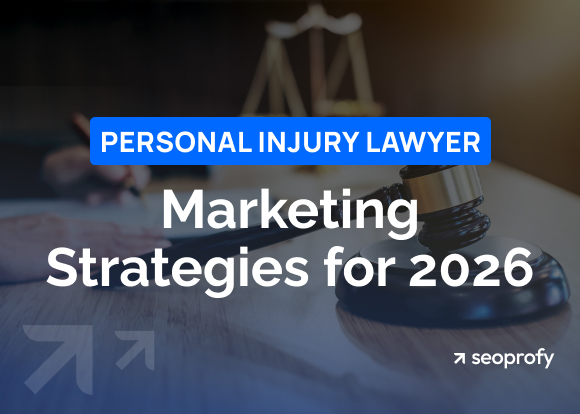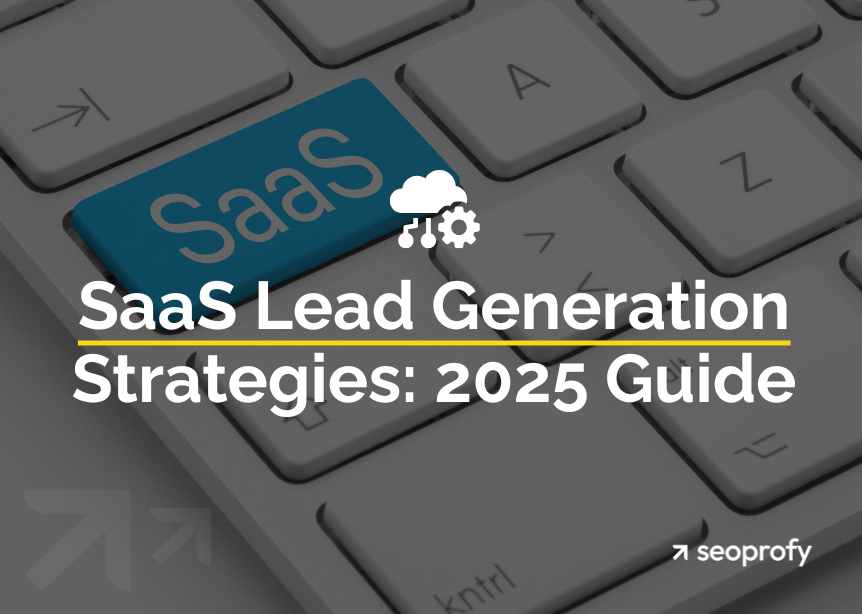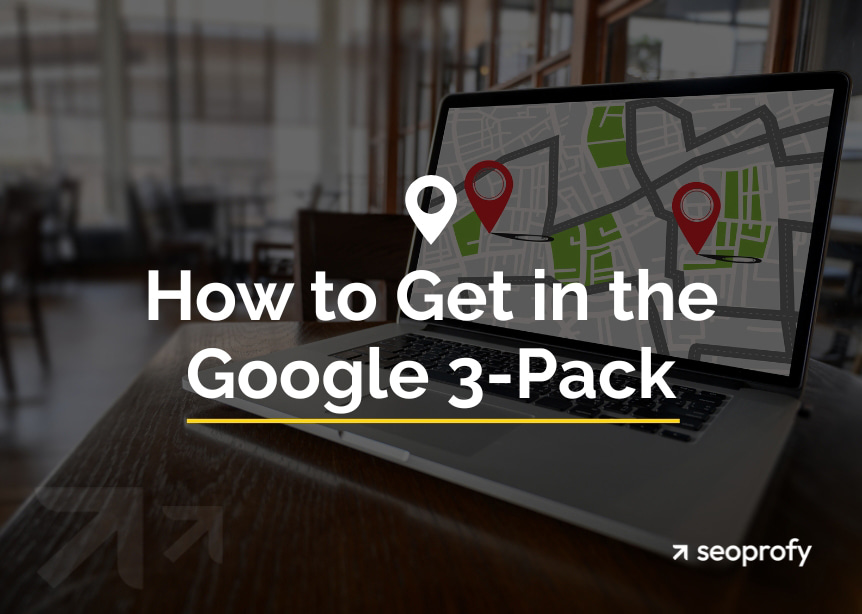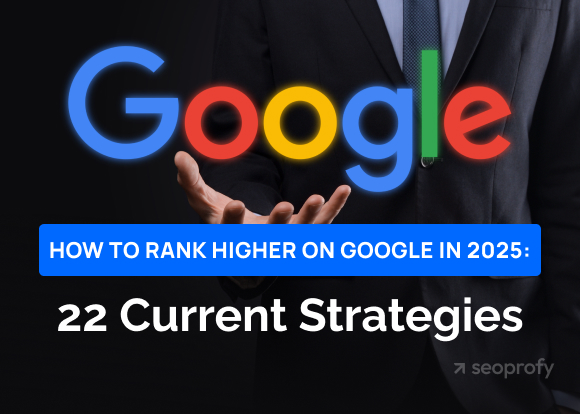To promote an eCommerce business in 2025, you need more than just a well-functioning website with good product descriptions. A comprehensive eCommerce content strategy is a must for connecting with customers, driving sales, and strengthening your brand appeal.
Content is the best way for eCommerce businesses to connect with their customers at different stages of the buyer’s journey. Content marketing is what makes sure that your content actually reaches your audience — and that it offers them exactly what they need when they need it. However, this is difficult to achieve without a well-thought-out content strategy for eCommerce.
In this guide, you’ll learn how to research your audience, choose the right content types, measure results, and adapt to emerging trends. We’ll provide practical ideas for content creation for eCommerce that will help you drive more sales.
- Valuable content drives sales: Only value-packed pieces that address customer pain points turn website visitors into clients.
- Audience research is a must: Understanding your audience means identifying their needs and preferences and offering relevant assistance.
- SEO is key for getting tangible results: It’s important to optimize your content to make it visible to a larger audience.
- Content diversity stimulates customer engagement: Share content across different media outlets to maximize reach and engagement.
Understand the Foundations of an eCommerce Content Strategy
It’s true that optimizing your content with keywords and sharing it across different platforms brings your business closer to potential customers. But random posts rarely deliver significant and lasting results. Success comes from understanding what content strategy means for eCommerce and why it matters for your bottom line.
So, what makes for a solid eCommerce content strategy, and why is it critical for the success of your marketing tactics? Let’s break this down into its essential parts.
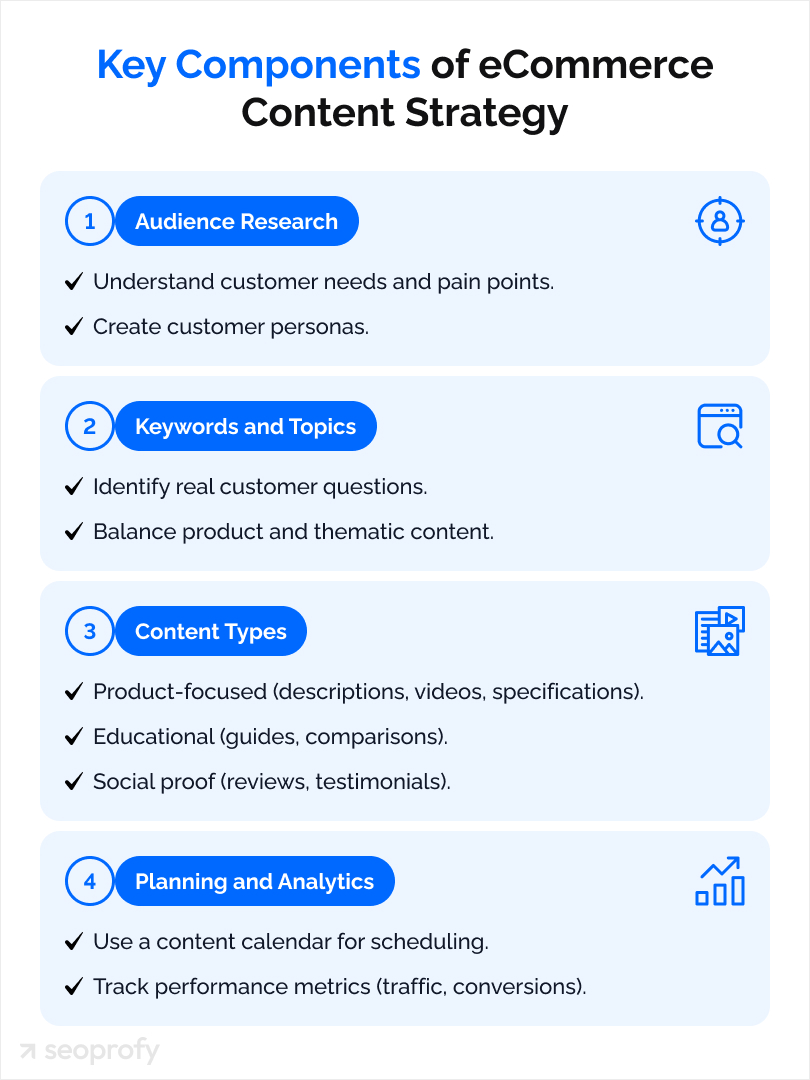
What Is an eCommerce Content Marketing Strategy?
Content marketing is a strategic approach focused on creating and sharing valuable content across media funnels to bring prospective customers closer to your business. The primary objective of an effective content strategy is to achieve a measurable result from a clearly defined audience. In the context of eCommerce, such a result is the conversion of a website visitor into a buyer and a loyal customer.
An eCommerce content marketing strategy includes different marketing tactics and calls for sustainable implementation. Essentially, it’s about boosting brand awareness by creating value in various content formats, e.g., blog posts, social media posts, or PDF guides.
A solid strategy covers:
- The types of content you’ll create (from how-to guides to product videos)
- Where you’ll publish this content (your website, social media, email)
- When you’ll share it
- How you’ll measure success
- Who’s responsible for each part of the process.
Such an approach ties together three crucial aspects of successful eCommerce content marketing: SEO performance. customer engagement, and conversion optimization.
Firstly, any piece of content must be optimized to reach its target audience. Integrating key principles of search engine optimization (SEO) is non-negotiable to increase both organic and referral traffic.
A proper SEO content strategy helps your website differentiate itself from other players in the industry, reinforcing your competitiveness. This isn’t about keyword stuffing — it’s about understanding what information your customers need and providing it in a way that search engines can easily understand and rank.
Second, a well-developed strategy stimulates customer engagement. Good content keeps customers interested in your brand beyond just product pages. Through how-to guides, comparison articles, and educational posts, you build relationships with customers and position your brand as a trusted advisor.
If the content reaches the intended audience and addresses their pain points (i.e., if it’s optimized and value-packed), it will most likely be shared by others. This, in turn, widens the pool of potential customers.
Finally, an effective content strategy focuses on driving conversion rates. Customers who gain helpful insights from you are more likely to end up making a purchase.
Why Is Content Strategy Essential for eCommerce Success?
A solid content strategy enhances the performance of eCommerce sites. Content is how online stores build relationships with customers they never meet face-to-face. Without helpful content, you’re just another catalog of products in an ocean of competitors.
However, how does it do so? By supporting customers at each stage of their buying journey:
- Awareness: Blog posts and guides that address common problems.
- Consideration: Product comparisons and detailed feature explanations.
- Decision: Customer reviews, use cases, and detailed product information.
- Post-purchase: Tutorials, maintenance guides, and tips for getting the most value.
People buy from brands they trust, and your content marketing strategy is key to customer education and trust-building. Your content shows expertise, answers questions, and helps customers make informed decisions. When someone finds your buying guide or comparison article genuinely helpful, they’re more likely to purchase from you instead of your competitors.
In addition, content marketing often delivers better long-term value in comparison to paid ads, which can bring quick results that don’t last. A well-written buying guide or product tutorial can continue bringing in customers for years, which makes it more cost-effective than constant ad spending.
In markets where products and prices are similar, content often makes the difference. Detailed size guides, care instructions, and authentic product demonstrations can set you apart from competitors who only provide basic product information.
Key Components of a High-Quality eCommerce Content Strategy
To ensure that you get the best results from your content marketing efforts, your strategy should include several key elements: target audience analysis, keyword research and topic selection, the right content types, and planning. These aspects work together to attract, engage, and convert new customers.
Audience Research and Persona Development
Of course, if you want to attract an audience, you first need to know exactly who you are targeting. For eCommerce brands, this means looking deeper than just age and location. You need to almost get inside their heads. What problems keep them up at night? What questions do they ask before buying? Why do they hesitate during checkout?
For in-depth target audience analysis, online retailers can combine a few approaches. First is data analysis — because your strategy should be based on real data, not some guesses or gut feelings. Study your website analytics, sales data, and customer service interactions. Look for patterns in buying behavior, popular products, and common questions. This quantitative data reveals what your customers actually do, not just what they say they do.
Next, take a look at who you are competing with. Competitor research can help you find unique insights for the content marketing journey. Check what content your competitors create and how their customers respond. Look for gaps in their pieces that you can fill. What questions are people asking on their social media that go unanswered?
You should also consider direct customer feedback. Determining what your existing customers and potential buyers say about their needs is important. Here are some ways to analyze this:
- Survey your customers about their buying experience
- Read product reviews to understand pain points and priorities
- Monitor social media comments and messages
- Analyze customer service conversations.
Once you’ve gathered this information, create buyer personas that feel like real people, not just demographic profiles. Include:
- Their main goals and challenges
- Typical questions they ask before buying
- Where they look for product information
- What might stop them from making a purchase
- How they prefer to consume content (video, text, infographics).
Comprehensive Keyword and Topic Research
The simple truth in eCommerce content marketing is that the best posts answer real customer questions. Keyword research helps you find these questions and understand which of them are worth the effort and how to answer them effectively.
Even more, it can help you discover opportunities for attracting more traffic from organic search results. If you incorporate targeted keywords in your content creation process, you can create pieces that meet your customers right when they are searching for the products you provide. Your eCommerce brand will get a higher chance of appearing in the search engine results pages for search queries related to your offers.
When researching keywords, pay special attention to the search intent. It’s a crucial concept in SEO, showing the user’s main goal when they are typing a phrase into the search bar. Different keywords signal different customer needs:
- “How to choose running shoes” = Research phase
- “Nike vs Adidas running shoes” = Comparison phase
- “Buy Nike Air Zoom Pegasus” = Ready to purchase
Your content should match this intent. Someone searching for “how to choose” needs educational articles, not a hard sell. Here’s an example of a buying guide at Lowe’s targeting users at the research stage:
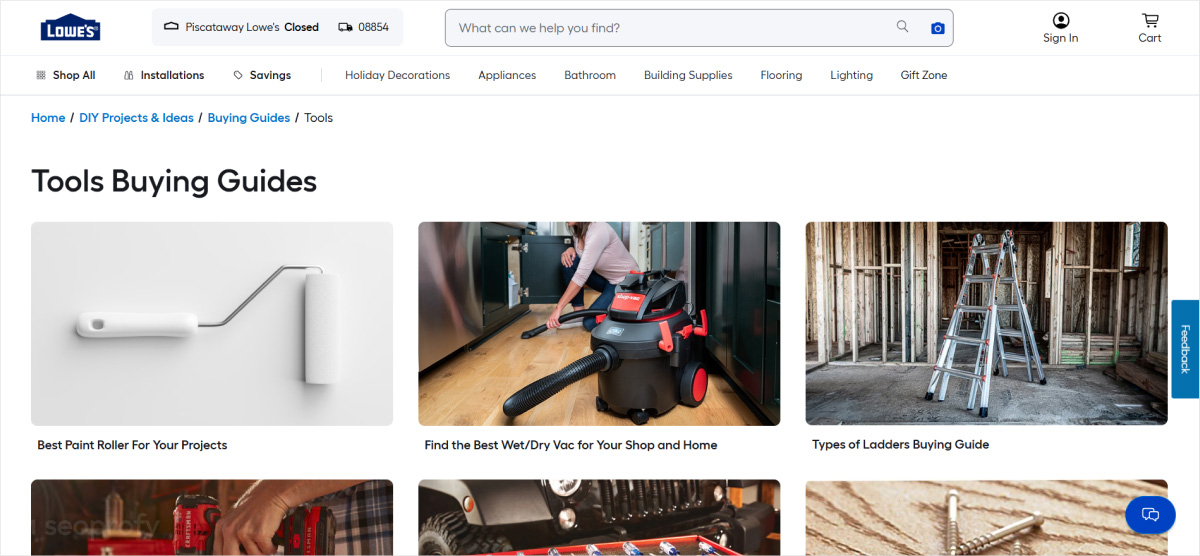
That doesn’t mean that you only need to create content targeting one intent. Your strategy should cover different intents, targeting people at different stages of the customer journey. Providing them with helpful information also leads to increased brand awareness and builds your authority.
eCommerce marketers recommend implementing topics that go beyond product keywords. Some content ideas are:
- Product use and maintenance
- Common problems your products solve
- Lifestyle topics related to your products
- Industry news and trends
- Expert tips and advice.
Continuing with our example of Lowe’s, the company also provides a wide range of informative articles targeting different customers’ questions and concerns:
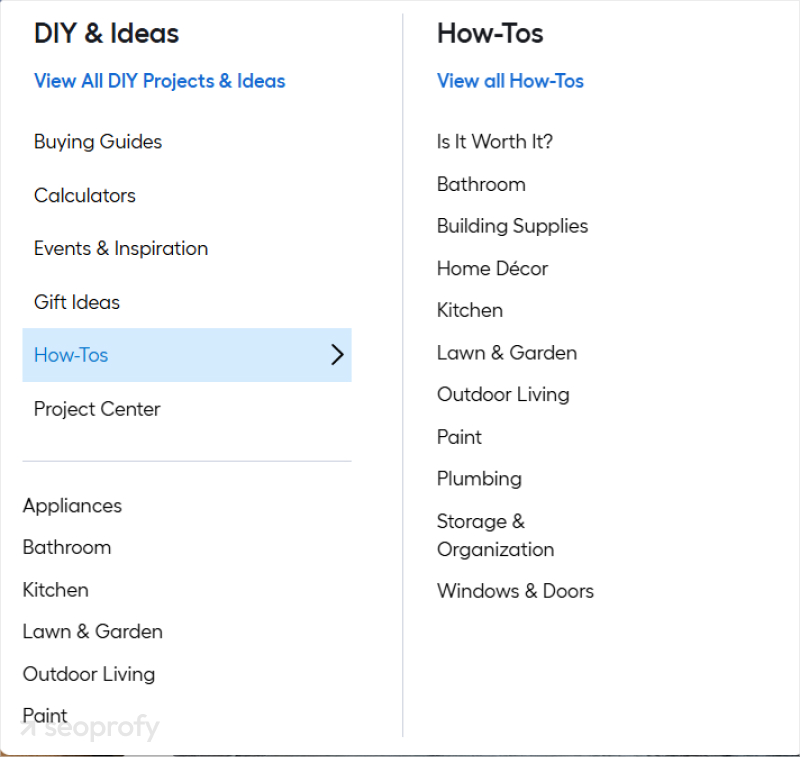
If this seems overwhelming, a reliable eCommerce SEO company can help you find the most effective keywords for your strategy. Working with experienced digital marketing specialists, you have a higher chance of reaching your targeted audience through search.
Content Types that Drive Engagement
According to HubSpot, one in three online marketers consider engagement a critical metric and a strategic goal for their content marketing efforts. However, what engaging content means can be very different depending on the audience. A diverse mix helps you reach more potential buyers and keeps your existing customers engaged.
Here’s an overview of the main categories you can explore:
| Category | Content Examples |
| Product-Focused |
|
| Educational |
|
| Social Proof |
|
Additionally, analyze which form of content works best for your audience. Do they prefer text-heavy articles? Or is it better to create videos and more visually appealing publications?
In most cases, a combination of different forms is the way to go. Still, determining the right balance between content types is important.
Content Calendar and Planning
An eCommerce content marketing strategy must be structured with a comprehensive calendar and plan. Random posting doesn’t work — a wrong balance of product-focused vs. educational posts can throw off potential buyers who need more information, while a lack of special seasonal publications can motivate your clients to look for them elsewhere.
You need to align content with your business goals and customer needs. Here’s how you can do that:
- Map content to different stages of the customer journey
- Plan around seasonal peaks and promotional events
- Balance different content types and topics
- Build in flexibility for trending topics and opportunities.
A content map can help you plan and analyze the performance of your posts. When developing a content map, analyze the following aspects:
- Which buyer persona each piece targets
- Where it fits in the customer journey
- The main keywords and topics it covers
- Distribution channels for each piece
- Success metrics for different content types.
Compiling these elements into a dedicated plan or calendar can help you stay organized and on track with your progress. Here’s an example:
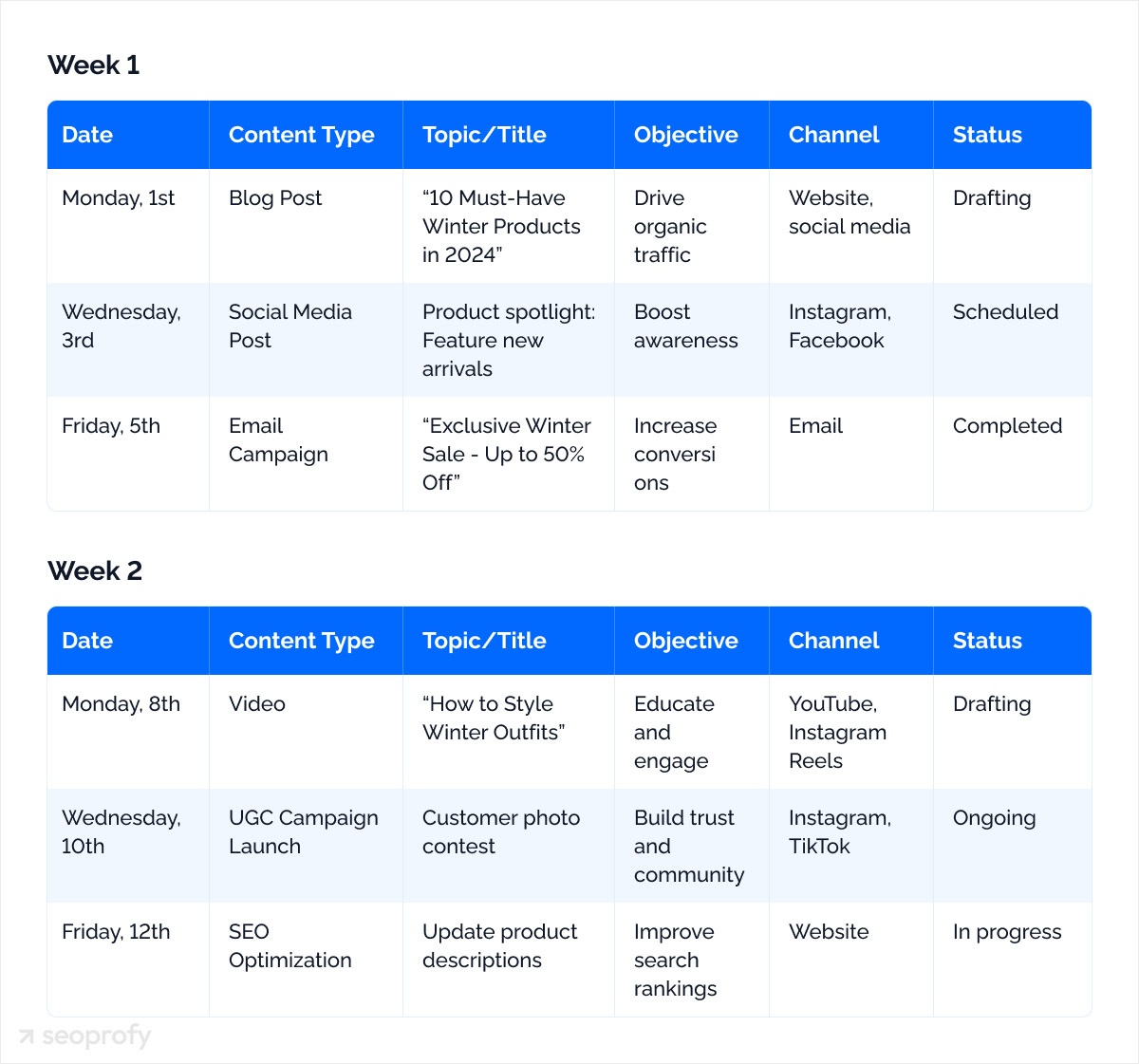
Execution and Optimization of Your Content Strategy
Creating a strategy is just the beginning. Here’s how to turn your content strategy into a system that delivers measurable business results.
Create High-Quality Content
Quality content stands out because it puts users first, answers their questions completely, and gives them confidence to make buying decisions. So, how do you create high-quality content?
Strive to provide your customers with original research and insights. They can probably find a blog post about choosing the best running shoes on other sites, so what can you offer? Or how can you create a better guide? Add value to your pieces by:
- Running customer surveys and sharing the findings
- Analyzing your sales data to spot trends
- Including expert insights from your team
- Sharing real customer success stories
- Testing products and documenting results.
Also, keep in mind that surface-level content rarely converts. Build trust by:
- Covering topics comprehensively
- Including specific examples and use cases
- Addressing common questions and concerns
- Backing claims with data and research
- Explaining complex concepts clearly.
Last but not least: make your content user-friendly! Good content isn’t just about what you say — it’s how you present it:
- Break text into scannable sections
- Use clear headings and subheadings
- Include relevant images and diagrams
- Add accessibility features
- Write in a clear, direct style
- Format content for mobile devices.
Distribution Channels
Even great content needs promotion to reach your audience. In eCommerce content marketing, it’s important to combine different distribution channels, as each of them serves a different purpose in your distribution strategy. The main channels for eCommerce companies include social media, email marketing, SEO, and paid ads.
Social Media
Social media platforms have become crucial marketplaces where customers discover and research products. However, social media marketing is challenging because your strategy needs to adapt to each platform’s unique environment. Instagram and TikTok excel at visual storytelling and short-form videos, while LinkedIn might be better for B2B eCommerce and professional insights.
- Choose the platforms that your audience is most active on
- Match content format to each social media platform
- Schedule posts for peak engagement times
- Encourage sharing and discussion
- Use platform-specific features (Stories, Reels, etc.)
- Engage with comments and messages
Email Marketing
Email remains one of the most effective channels for eCommerce content distribution. It gives you direct access to interested customers and lets you personalize messages based on their behavior and preferences. The key is to provide value in every email, not just push sales messages.
- Segment your list based on customer interests
- Create targeted campaigns
- Share exclusive information with subscribers
- Use automated sequences for new customers
SEO
This is your content’s foundation for long-term success. When done right, SEO brings a steady stream of qualified web traffic to your store. Focus on creating high-quality pieces that answer real customer questions, then optimize them for search engines without sacrificing readability.
- Optimize page structure and metadata
- Build internal links between related content
- Create content hubs around main topics and target keywords
- Focus on user experience signals
- Keep technical SEO elements up to date
Keep in mind that a good SEO strategy should also cover other aspects of your website’s performance. Check out our SEO guide for eCommerce.
Paid Promotion
Paid advertising through platforms like Google Ads or Facebook can amplify your best content and help you reach new audiences quickly. The trick is to be strategic about which content you promote and to whom.
- Boost high-performing organic content
- Target specific audience segments
- Test different ad formats and placements
- Retarget website visitors with relevant content
- Monitor cost per engagement metrics
Continuous Improvement and Updates
The work doesn’t stop after publishing your content. You need to update it regularly to keep it effective.
- Track your performance: Monitor key metrics like page views, time on page, conversion rates, social shares, and engagement.
- Analyze user feedback: Learn from your audience by watching how users interact with content, asking for feedback through surveys, monitoring comments and questions, and noting common pain points.
- Update existing content: Keep it current by checking facts and statistics regularly, adding new information and examples, and removing outdated references.
How to Measure the Success of Your eCommerce Content Marketing Strategy
Good measurement helps you understand what’s working and what needs adjustment. Let’s examine the key metrics and analysis methods that show if your strategy is delivering results.
Metrics to Track
When working on eCommerce content marketing, you need to understand the exact impact of your strategy on your business. To get specific insights and data, we recommend tracking your organic traffic, engagement rates, conversion rates, and ROI. These metrics can be analyzed with SEO and marketing tools like Google Search Console, Google Analytics, Ahrefs, Semrush, and more.
Organic traffic shows how well your website attracts potential clients through search engines. Track these specific metrics:
- Monthly organic visitor growth for each content type
- New vs. returning organic visitors
- Search performance for target keywords
- Geographic distribution of organic traffic
- Mobile vs. desktop website traffic ratio.
High engagement indicates your pieces resonate with your audience and help build brand trust. Key engagement metrics include:
- Average time spent on content pages
- Scroll depth on long-form posts
- Pages viewed per session
- Social shares and comments
- Newsletter signup rates from content pages.
Conversion rates demonstrate how your content directly impacts your revenue. Monitor these aspects:
- Content-assisted conversion rate (how often viewers become customers)
- Product page conversion rates after content interaction
- Email signup conversions from different content types
- Add-to-cart rate from content pages.
Most importantly, pay attention to your return on investment (ROI). Calculate the actual business value your content creates:
- Revenue attributed to content-driven sales
- Content creation and distribution costs
- Customer acquisition cost through content
- Customer lifetime value of clients acquired through content
- SEO cost savings compared to paid traffic.
Ultimately, your goal is to understand not just how much traffic your content brings, but how effectively it turns that traffic into sales.
Analyze User Behavior
In eCommerce content marketing, your main focus should be your users. If you understand how users interact with your content, you can find opportunities to improve your strategy and increase conversions. Three key metrics can help you assess user behavior.
Bounce rates provide vital context about content effectiveness. A high bounce rate isn’t always negative — a help article might have a high bounce rate because it quickly answers the user’s question. However, a buying guide should encourage further exploration. Monitor bounce rates across different publication types and traffic sources to understand where you meet user needs and where you don’t.
Time on page reveals how thoroughly users engage with your posts. When visitors spend several minutes on a buying guide or product comparison, it suggests they’re finding value in the information. On the other hand, short visits to long-form publications could indicate a mismatch between user intent and content delivery. Watch for patterns in reading time and scroll depth to gauge engagement.
Click-through rates show how effectively your content moves users toward purchase decisions. Track these indicators:
- Internal link clicks to related pages
- Product link engagement within articles
- Call-to-action button effectiveness
- Email click-through rates.
To avoid content marketing pitfalls and keep your strategy moving in the right direction, you need a custom plan built on proven SEO principles and real data.
SeoProfy can help you create and execute a successful content strategy that delivers real results. Book a free consultation today and start seeing benefits like:
- Higher search rankings
- Increased online visibility
- More organic traffic and conversions
What Will the Future of eCommerce Content Look Like?
There’s a lot happening in the content marketing industry today, and eCommerce content marketing is also influenced by these trends. Let’s discuss the changes you should watch out for.
Integrating AI and Automation
According to HubSpot’s report, 68% of businesses have noticed an increase in ROI from content marketing when they started using AI. The same research shows that marketers mostly use AI for writing marketing copy. However, it’s not about replacing human creativity — it’s about making it more effective.
AI in digital marketing is a great way to research top-performing topics for blog content and provide personalized suggestions to users. It can also be used for automation. For example, you could create a smart publishing schedule based on user behavior patterns detected by AI, automatically update posts in case of product changes, or provide real-time pricing updates in your eCommerce store.
Aligning Content with Consumer Trends
Shopping habits and preferences keep changing. Depending on your products, your content needs to match what customers want.
For example, more than 70% of retail website visits are from mobile devices. If you notice a similar trend in your target audience, pay special attention to mobile optimization in your strategy.
When it comes to content formats, we can see a clear influence of short-form video platforms. According to Wyzowl, 44% of consumers prefer watching a short video to learn about a product instead of infographics or text-based articles. This is an important trend for eCommerce brands to consider.
Lastly, eCommerce businesses should take into account the growing importance of sustainability and ethical marketing practices. Consumers are more conscious of the impact brands and companies have on the environment and society. Being open and transparent with your consumers will increase your authority and trustworthiness.
If you have made a positive impact on these issues or implemented sustainable practices, be sure to demonstrate this. Here’s an example from Fresh, a beauty products store:

Building a Long-Term Content Framework
Success in 2025 and beyond requires a content framework that can grow and adapt to your business. Don’t chase short-term trends — focus on systems and processes that consistently deliver value to your customers.
For a start, create detailed guidelines for content creation, including brand voice, formatting standards, and quality benchmarks. This will ensure consistency even if your team grows or changes. Set up efficient workflows for content planning, creation, review, and updates to maintain quality without creating bottlenecks.
Also, create pieces that serve multiple purposes and can be easily updated or repurposed. For example, a comprehensive buying guide can be split into social media posts, email sequences, and fragments for a product page. This approach helps you create more with less effort and maintain consistency across channels.
Conclusion
Content strategy for eCommerce is more complex than ever before — however, it can also make your business more powerful. Today, winning brands don’t just sell products, they create digital experiences that inform, engage, and inspire their customers to action.
Here’s what separates successful eCommerce content strategies from the rest:
- Data-driven decision-making: The top performers base their content decisions on solid customer data and performance metrics.
- Strong customer focus: Every piece serves a specific customer need at a particular stage of their buying journey.
- Strategic distribution: Just creating content isn’t enough, so they ensure it reaches the right audience through carefully chosen channels.
- Consistent measurement: Regular performance tracking and analysis help them spot opportunities and fix issues.
- Adaptability: They stay flexible to embrace new technologies and trends while maintaining their core content principles.
Ready to transform your eCommerce content marketing? Contact us for a free consultation and let’s discuss how we can help your online store stand out in 2025 and beyond.






